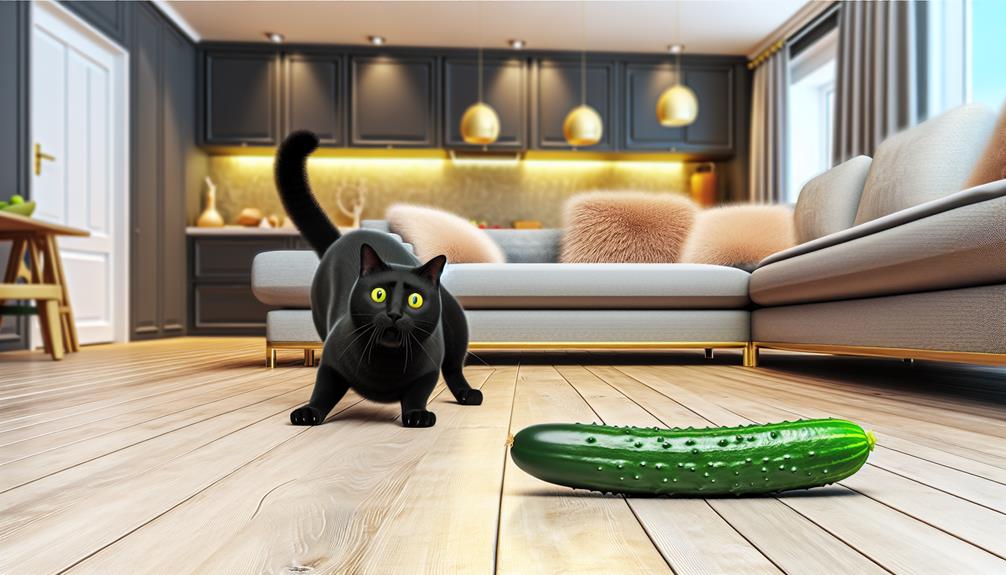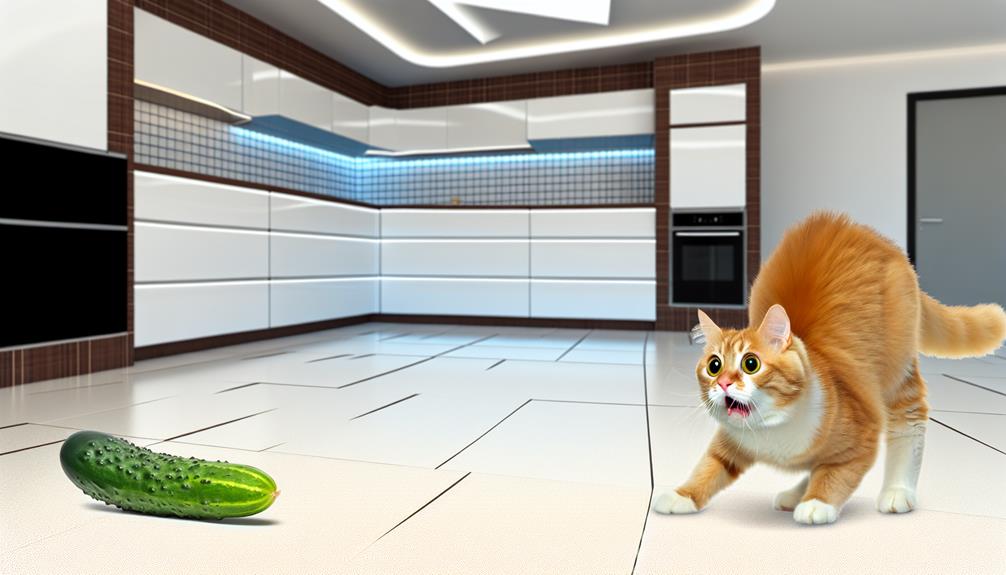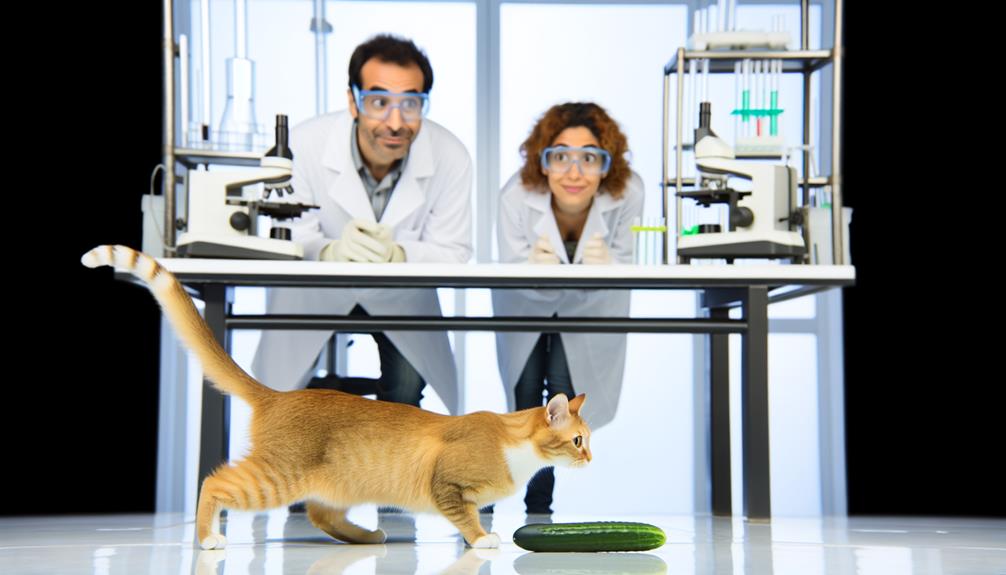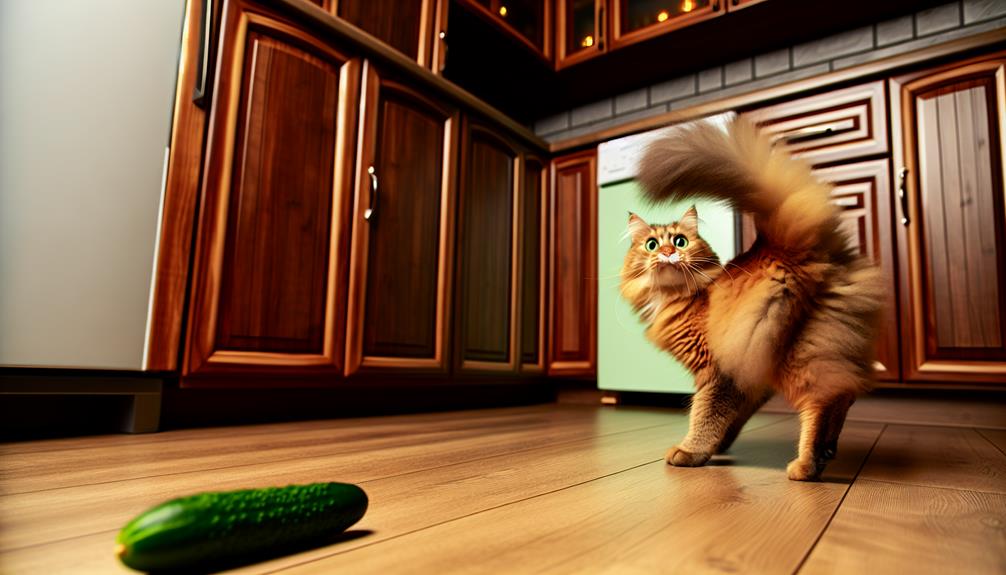Imagine you place a cucumber behind your cat while it's eating, and the moment it turns around, it leaps into the air in sheer panic. This bizarre reaction, which you've probably seen in countless viral videos, isn't just a quirky feline trait. Cats are hardwired to respond to sudden changes in their environment, and the cucumber's snake-like appearance might trigger their primal instincts. There's more to this phenomenon than meets the eye, so let's explore the underlying reasons behind such a peculiar behavior.
The Startle Reflex
When discussing why cats are scared of cucumbers, it's essential to understand the startle reflex. This reflex is an automatic, instantaneous reaction to an unexpected stimulus. In cats, the startle response is deeply rooted in their instinctual behavior. When a cat encounters an object like a cucumber suddenly appearing behind it, the cat's nervous system triggers a rapid, involuntary reaction designed to prepare it for potential danger.
You might notice that when a cat is startled by a cucumber, it jumps back or even runs away immediately. This is because the startle response activates the cat's fight-or-flight mechanism. The cat's brain, upon detecting an unexpected object in its environment, quickly assesses the situation. Given that cats are both predators and prey in the wild, their startle reflex is finely tuned to respond to potential threats. This reflex is not a conscious decision but rather an instinctual behavior that has evolved to maximize the cat's chances of survival.
The startle response involves several physiological changes. Within milliseconds, the cat's heart rate increases, muscles tense, and adrenaline surges. These changes prepare the cat to either confront the perceived threat or flee. The sudden appearance of a cucumber, an unfamiliar object, exploits this reflex. The cat's finely-tuned senses detect the object's presence without it being anticipated, triggering an immediate defensive reaction.
Snake-Like Appearance
The visual resemblance of cucumbers to snakes plays a significant role in why cats react so dramatically to them. When you place a cucumber near a cat, the elongated, cylindrical cucumber shape can closely mimic that of a snake, triggering a primal fear response. This reaction is deeply embedded in feline behavior, rooted in their evolutionary history as both predators and prey.
Cats have evolved to be hyper-vigilant about their surroundings, and their acute vision allows them to detect potential threats quickly. A sudden appearance of a cucumber can be perceived as a snake, leading to an immediate flight response. This isn't just a random scare; it's an instinctual behavior aimed at self-preservation.
| Attribute | Cucumber | Snake |
|---|---|---|
| Shape | Long, cylindrical | Long, cylindrical |
| Color | Green, varying shades | Green, brown, or patterned |
| Surface texture | Smooth | Scaly |
| Movement potential | Stationary (when placed) | Slithering |
Your cat's brain is wired to avoid snakes because they could pose a lethal threat. The cucumber shape, especially when it's spotted unexpectedly, taps into this deep-seated fear. The suddenness of the cucumber's appearance is vital; if introduced gradually, the cat might not exhibit such a strong reaction.
In essence, the cucumber's visual and textural attributes mimic those of a snake closely enough to trigger a defensive response in cats. By understanding this aspect of feline behavior, you're better equipped to comprehend why a seemingly harmless vegetable can cause such an extreme reaction. This knowledge underscores the importance of considering your pet's instincts when interpreting their actions.
Territorial Instincts

Cats' territorial instincts are a key factor in their fear of cucumbers. When something unfamiliar, like a cucumber, suddenly appears in their space, it can be perceived as an intruder, triggering defensive reactions. This behavior is rooted in their instinct to protect their territory from potential threats.
Protecting Their Space
Understanding a cat's territorial instincts sheds light on their peculiar reaction to cucumbers. Cats are inherently territorial creatures, and they establish space boundaries to create a sense of environmental comfort. When a foreign object, such as a cucumber, suddenly appears in their perceived safe zone, it can disrupt their sense of security. This unexpected intrusion challenges their established territory, causing a startle response.
You might notice that cats often patrol their environment, marking their domain with scent glands located on their cheeks and paws. This behavior is essential for maintaining their space boundaries. A cucumber, placed surreptitiously behind them, can trigger a defensive reaction because it represents an unknown element within their defined territory. The cat's instinctual response is to flee, ensuring their safety from potential threats.
Analyzing this behavior shows that it's not the cucumber itself but the sudden presence of an unfamiliar object in their environment that elicits such a dramatic response. This reaction highlights the significance of maintaining environmental comfort for your feline friend. By understanding their need for a stable and predictable territory, you can better appreciate why they react so strongly to unexpected changes in their space.
Fear of Intruders
Recognizing a cat's territorial instincts helps us understand their acute fear of intruders. Cats are inherently territorial animals, and any unexpected object in their space can be perceived as a potential threat. In the wild, predator awareness is essential for survival. Your domestic cat retains this instinctual vigilance, scanning their environment for signs of danger. When a cucumber is suddenly introduced into their familiar setting, it can trigger an immediate fear response due to its unexpected presence.
Environmental stressors play a significant role in a cat's reaction to perceived intruders. A cat's home is their safe haven, and any unfamiliar object can disrupt this sense of security. The sudden appearance of something unknown, especially something elongated and snake-like, can be interpreted as a stealthy predator encroaching on their territory. This perception is heightened by their keen senses, which constantly monitor for any changes in their surroundings.
Therefore, understanding your cat's fear of intruders, such as a cucumber, involves recognizing their deep-seated territorial instincts and the role of predator awareness. By acknowledging these factors, you can better appreciate why such seemingly innocuous objects can cause significant distress and anxiety in your feline companion.
Defensive Reactions Triggered
When a cat perceives an unexpected object like a cucumber in its environment, its defensive reactions are immediately triggered due to deep-seated territorial instincts. Cats are highly territorial animals, and any unfamiliar item, especially one with the elongated cucumber shape, can be perceived as a potential threat. This is deeply rooted in their survival mechanisms which prompt them to react swiftly to guarantee their safety.
Your cat's brain is hardwired to respond to sudden movements and unfamiliar shapes. When a cucumber is placed behind a cat without its knowledge, the element of surprise amplifies the perceived threat. The cucumber shape, resembling that of a snake or another predator, can heighten their instinctual response. In the wild, cats would need to be vigilant for such dangers to avoid predation.
Upon detecting the cucumber, your cat's body may exhibit several defensive reactions: puffing up its fur, arching its back, or making rapid escape movements. These behaviors are not just random; they're deeply ingrained responses aimed at protecting their territory and guaranteeing survival. Understanding this can help you recognize why such innocent objects can cause your cat such immediate and intense reactions.
Disruption of Routine
A significant factor contributing to cats' fear of cucumbers is the disruption of their routine. Cats are creatures of habit, and any unexpected change in their environment can lead to stress and anxiety. When you place a cucumber behind a cat, you're introducing a sudden and unfamiliar object into their familiar space. This abrupt alteration can be perceived as a threat, triggering a fear response.
Routine changes can have profound effects on a cat's psychological well-being. Cats rely on predictability to feel secure. Sudden introductions of objects, like cucumbers, disrupt this predictability, leading to heightened stress levels. Environmental factors play an essential role in how cats perceive their surroundings. A stable environment where objects are static and predictable helps maintain their sense of security. When this stability is compromised, it can result in a fear response.
Moreover, cats have a highly developed spatial memory. They remember the layout of their environment and the placement of objects within it. A cucumber, an object not usually present in their everyday setting, disrupts this spatial memory, causing confusion and fear. The unexpected presence of such an object can make them feel their territory is being invaded, further exacerbating their anxiety.
Visual Sensitivity

Cats' fear of cucumbers can also be attributed to their heightened visual sensitivity. Unlike humans, cats possess a sophisticated visual perception system designed to detect subtle movements and changes in their environment. This acute sensitivity helps them hunt and avoid potential threats. When a cucumber is placed behind a cat, it often goes unnoticed until the feline turns around. The sudden appearance of the unfamiliar object can trigger a startle response due to their instinctual need to stay alert for predators.
Your cat's vision is optimized for low-light conditions, making them excellent nocturnal hunters. However, this visual adaptation also means that sudden, unexpected changes in their surroundings can be particularly jarring. The elongated shape and green color of a cucumber might bear a loose resemblance to snakes, a natural predator, which could further exacerbate the cat's reaction. This visual perception can lead to a misinterpretation of the cucumber as a potential threat, prompting a flight response.
Moreover, cats have a wider field of vision compared to humans, approximately 200 degrees compared to our 180 degrees. This means they can detect movements and objects from the periphery more effectively. When a cucumber appears in this peripheral vision zone, it can be perceived as an immediate danger. Such heightened visual sensitivity is vital for their survival in the wild but can lead to exaggerated reactions in a domestic setting.
Understanding feline behavior and their visual sensitivities can help you appreciate why seemingly harmless objects like cucumbers can elicit such dramatic responses. By recognizing these triggers, you can create a more comfortable and secure environment for your cat.
Fear of the Unknown
When a cucumber suddenly appears in a cat's environment, it can trigger an instinctual defense mechanism due to the unexpected nature of the object. You're observing a primal response where the cat's fear of the unknown prompts a rapid, startled reaction. This behavior is rooted in survival instincts, as unfamiliar items could pose potential threats.
Sudden Appearance Startles Cats
Surprisingly, the sudden appearance of an unfamiliar object can startle cats considerably. When you introduce something like a cucumber into their environment without warning, it disrupts their sense of security. Cats are highly sensitive to sudden movements and unexpected objects, which can trigger an immediate fear response.
Cats' heightened senses make them acutely aware of their surroundings. The sudden placement of a new object, especially behind them, can create a shock effect. Here's a breakdown of how this reaction unfolds:
| Cat Behavior | Trigger | Resulting Action |
|---|---|---|
| Calm and relaxed | No sudden movements | Continues normal activity |
| Alert but calm | Minor unexpected object | Brief investigation |
| Startled | Sudden appearance | Quick jump or retreat |
| Defensive stance | Unfamiliar object close | Potential for hissing |
| Heightened anxiety | Repeated sudden objects | Sustained stress |
You'll notice that the introduction of an unexpected object can rapidly escalate a cat's anxiety. This sensitivity to sudden changes is deeply ingrained in their behavior. Sudden appearances disrupt their controlled environment, making them feel vulnerable. Understanding this aspect helps explain why something as innocuous as a cucumber can provoke such a dramatic response in your feline friend.
Instinctual Defense Mechanism
An important aspect of feline behavior is their instinctual defense mechanism, which often manifests as a fear of the unknown. This evolutionary adaptation is essential for their survival. When a cat encounters an unfamiliar object, such as a cucumber, their immediate response is driven by an ingrained need to protect themselves. This reaction is rooted in their prey awareness, a key survival trait passed down through generations.
You'll notice that when a cat suddenly sees a cucumber, it often leaps away or shows signs of distress. This is because their instinctual defense mechanism interprets the unexpected appearance as a potential threat. In the wild, this quick reaction could mean the difference between life and death, helping them avoid predators or other dangers.
Scientific Studies

To explore why cats exhibit such a strong reaction to cucumbers, scientific studies have aimed to shed light on this puzzling behavior. Researchers have conducted various experiments to understand the underlying mechanisms driving such intense feline reactions. One hypothesis suggests that this cucumber behavior is rooted in a survival instinct, where cats may mistake the cucumber for a snake or another potential predator.
In controlled environments, scientists have observed cats' responses to cucumbers placed behind them while they are eating. The abrupt appearance of the cucumber often triggers a startle response, characterized by leaping, arching of the back, and rapid retreat. This reaction is a classic example of the fight-or-flight response, which is an automatic physiological reaction to an unexpected stimulus.
Further studies have investigated the sensory aspects of this behavior. Cats have highly developed senses of sight and smell, which play essential roles in their environmental awareness. When a cucumber suddenly appears in their immediate vicinity, it disrupts their sensory landscape, leading to confusion and alarm. The visual similarity of a cucumber to a snake, combined with the sudden introduction of an unfamiliar object, can be particularly jarring for cats.
Additionally, researchers have noted that not all cats react the same way to cucumbers. Variability in feline reactions may be influenced by individual differences in temperament, past experiences, and the specific context in which the cucumber is introduced. These factors highlight the complexity of animal behavior and the importance of considering multiple variables when interpreting scientific findings.
Conclusion
In summary, you've seen how a cat's startle reflex, combined with the cucumber's snake-like appearance, triggers primal fear. When a cucumber disrupts their territory, it upsets their apple cart, heightening anxiety. Cats' visual sensitivity and fear of the unknown amplify this reaction. This defensive behavior, deeply rooted in their evolutionary history, guarantees their survival. Scientific studies confirm that such responses are natural, reinforcing the intricate balance of a cat's instincts and environmental interactions.
